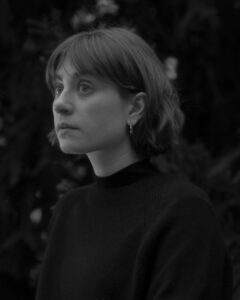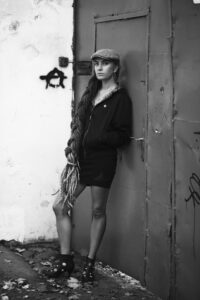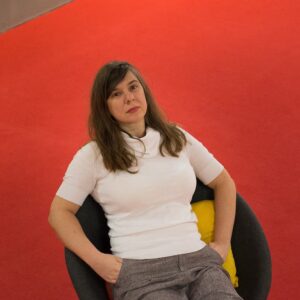Anna Ádám

– born in 1983. Visual artist, stylist, costume designer and makeup artist. She graduated at ENSAPC in France in 2016, specializing in intermedia studies. Her work is characterized by an intermediatic character in every possible sense of the word: she “curates theatre” and “choreographs exhibitions”. She conceptualizes and uses the exhibition space as a theatre and the theatre as an exhibition space: her installations act as scenery settings and her plinths work as a stage during her performances. Her artistic practice focuses on the formation and transformation of the most basic human intellectual, spiritual and physical connections and interactions in the perspective of contemporary social issues (social media, dating apps, political issues, trends etc.). In her glasshouses and gardens, carrying also a strong allegorical sense, that she builds and photographs, she raises in-situ altars to friendship, queer love or erotica. In the language of flowers she encodes and presents in her ceramics and objects a large spectrum of dilemmas, secrets, duels, and pains that might exist between two people. Anna Ádám founded Gray Box in 2014, a company she is the art director of ever since. As of 2015, she works as a costume designer, and as of 2017 she also acts as a make-up artist in contemporary visual art and theatre projects. She designs her own fashion collection, which she presents in galleries, museums, and theatres in a form of performance or installation. Anna Ádám also creates and holds workshops and trainings. She developed her own method based on an interdisciplinary collective creative process. Her approach uses visual arts, performing arts, and performance art as a tool to explore both theory- and business-oriented topics (eg. identity, gender, harassment, leadership, innovation…). She lives and works between Budapest and Paris.
I was initially interested in design. I studied styling and design; I created amorphous collections and then began to explore the performative and choreographic possibilities of clothing, to interpret the runway as a stage, and create fashion performances. I came to regard the body as topography: sensitive terrain that is both physical and immaterial (in combining empathy, intuition and emotions) – a battleground that has been fought over for millennia. In 2016, I earned an MA from École Nationale Supérieure d’Arts de Paris-Cergy (FR). Presently, I work as an artist, and I am also active in education and community building.
Through the use of marginal forms and aesthetics that have been underrepresented in the contemporary canon and undervalued on the art market, I question conventions and norms, as well as individual and social expectations. In my works, I examine from a feminist perspective the dynamics of superior positions of power, dominance within relationships, and oppression and exploitation.
Horizontal collaboration that knows no boundaries in art is a key component of my creative method: in 2005, I started a theatre company at the Hungarian Institute in Paris; in 2014, I founded an artist collective in Budapest. Since 2019, I have been an artist of the Gray Box company, based in Paris.
I believe that contemporary art can be democratic, less exclusionist, more solidarity based and community-oriented. In my opinion, contemporary art that reaches its viewers only through mediation – for instance, with the help of descriptive texts, exhibitions or museum education workshops – is addressed not to the wider public but to a privileged segment of society. Instead of popularizing initiatives that endeavour to make art more accessible to a wider audience, I feel there is a need for reform towards a contemporary art that is more autonomous, direct, accessible, interesting, and open to a broader spectrum of social strata 12.
Since 2016, I have visited numerous urban and rural art institutions both in Hungary and abroad,
as well as art events, alternative and nightlife venues, community spaces, school gymnasiums, public spaces, the Ludwig Museum and Blaha Lujza Square. I have presented my works in theatres, including the E-Werk Kulzurzentrum (DE), the Théâtre National de Syldavie (FR), the Piccolo Teatro (DE) and the RHIZ techno club in Vienna, as well as in such exhibition venues as the Yerevan Modern Art Museum (AM), the Museum of National History (FR), and a feminist community space in Instanbul called Purespace (TUR). In 2019, I taught performance art at the Academy of Fine Arts in Vienna (AU) and at Artois University (FR), and also held workshops for immigrants within the framework of the Grand Festival in Paris.
Sadly, women in Hungary still earn a salary that is lower than men’s, they still cannot count on state protection when they are being abused by their partners, and they cannot rely on the government for the safeguarding of their rights. The government’s refusal to ratify the Istanbul Convention, the systemic embedding of discriminative stereotypes in political discourse, and the repeated repudiation of efforts to assert women’s rights and equal opportunity, all comprise part of the government’s fight against ‘gender ideology’, used to popularise and legitimise misogynistic, sexist and homophobic views. My dream project, ‘School of Disobedience’3, which is an experimental and transdisciplinary art school and fight club, aims to help women use their voice, gain visibility, question social norms and expectations, challenge conventions and traditions, and confront the rules and stereotypes that were ingrained in them as part of their socialisation. The program is free and open to all women. The primary objective of its courses, which are simultaneously theoretical and practical, is to boost participants’ self-confidence, foster their creativity, and to provide them with the support, knowledge and tools to resist, protest and take action. The School of Disobedience offers a safe, non-hierarchical and judgement-free space where women can express themselves openly, and develop alternative viewpoints and critical thinking. Participants are encouraged to release their fears, go beyond their limits, transcend their boundaries, push themselves out of their comfort zone and believe in their dreams.4567
The statement was written in cooperation with curator Fruzsina Kigyós (2021).
1Image: Anna Adám,exhibition “Sorry not sorry”, 2018, MU Theater, Budapest. Courtesy of the artist.2Image: Anna Ádám, exhibition “No hook-ups, only serious”, 2018, Studio of Young Artists’ Association, Budapest. Courtesy of the artist.
3See: schoolofdisobedience.org
4Image: Anna Ádám, My Genesis Story, 2018, photo. Courtesy of the artist.
5Image: Anna Ádám, My Genesis Story, 2018, photo. Courtesy of the artist.
6Image: Anna Ádám, Album of Lost Loves, 2018-2019, Drawing, sewing, collage, 30x45 cm. Courtesy of the artist.
7Image: Anna Ádám, Album of Lost Loves, 2018-2019, Drawing, sewing, collage, 30x45 cm. Courtesy of the artist.
– szül. 1983 – képzőművész, stylist, jelmeztervező és makeup artist. 2016-ban Franciaországban (ENSAPC) diplomázott intermédia szakon. Munkáit a legtágabb értelemben vett intermedialitás jellemzi: színházat kurál és kiállítást koreografál. A kiállítóteret egyfajta képzőművészeti színházként működtetve értelmezi, a színházból pedig kiállítóteret csinál: installációi díszletként, rendhagyó posztamensei pedig színpadként is operálnak performanszai alatt. Művészi praxisának kutatási területe a legelemibb emberi szellemi-, lelki- és testi kapcsolati és kapcsolódási formák kialakulásaira és átalakulásaira fókuszál kortárs társadalmi jelenségek fényében (közösségi média, ismerkedős appok, aktuálpolitika, trendek…). Allegorikus jelentésekkel bíró üvegházaiban és kertjeiben, melyeket fotóz is és épít, in-situ oltárokat állít a barátságnak, a queer szerelemnek, az erotikának. Kerámiáiban, objektjeiben rejtjelezve, virágnyelven vannak elültetve két ember közötti viszonyulási minőségek széles spektrumának dilemmái, titkai, párbajai és fájdalmai egyaránt. Ádám Anna 2014-ben megalapította a Gray Box-ot, melynek a mai napig művészeti vezetője. 2015 óta jelmeztervezőként, 2017 óta pedig makeup artistként is dolgozik kortárs képzőművészeti és színházi projektekben. Saját ruhakollekciókat tervez, melyeket installációk és performanszok formájában mutat be galériákban, múzeumokban és színházakban egyaránt. Ádám Anna téma specifikus és cél-orientált egyéni és csoportos workshopokat és trainingeket is tart művészeti és munkahelyi környezetben. Sajátos módszertana a pszichológia, a társadalomtudományok és a művészetek elméletének, eszköztárának és formanyelvének kreatív ötvözésére és tudatos használatára épül. Budapest és Párizs között él és dolgozik.
Kezdetben a design érdekelt, stylingot tanultam és tervezést, amorf kollekciókat készítettem, majd elkezdtem a ruha performatív és koreográfiai lehetőségeit kutatni, a kifutót színpadként értelmezni, divat-performanszokat csinálni. Az testre egyre inkább egy érzékeny, egyszerre fizikális és immateriális – empatikus, intuitív képességet, érzelmeket ötvöző – topográfiaként kezdtem tekinteni, egy olyan hadszíntérként, aminek a kisajátításáért, uralásáért évezredek óta folyik a harc. 2016-ban végeztem mesterképzésemet az École Nationale Supérieure d’Arts de Paris-Cergy (FR) művészeti egyetemen. Jelenleg az alkotás, az oktatás és a közösségépítés területén tevékenykedem.
Munkáimban a kortárs kánonban alulreprezentált, és a művészeti piacon alulértékelt marginális formák és esztétikák használatán keresztül a konvenciókat, normákat, egyéni és társadalmi elvárásokat kérdőjelezem meg. Visszatérő alkotásaimban a hatalmi fölény, domináns viszony, elnyomás, kizsákmányolás feminista perspektívából történő vizsgálata.
Alkotói módszeremnek egyik alapja a horizontális, művészeti határokat nem ismerő együttműködés: 2005-ben a párizsi Magyar Intézetben színházi társulatot alapítottam, 2014-ben Budapesten művészkollektívát. 2019. óta a párizsi székhelyű Gray Box társulat művésze vagyok.
Hiszek abban, hogy a kortárs művészet lehet demokratikus, kevésbé kirekesztő, szolidáris és közösségi. Szerintem az olyan kortárs művészet, amelynek az alkotásait csak közvetítéssel tudja befogadni a néző, például leírószöveg, tárlatvezetés vagy művészetpedagógiai foglalkozás segítségével, nem a széles közönségnek szól, csupán a társadalom egy privilegizált szegmenségnek. A népszerűsítésen és szélesebb körű befogadhatóságon fáradozó kezdeményezések helyett a kortárs művészet reformálását hiányolom, egy autonóm, közvetlenebb, szélesebb társadalmi rétegek számára is nyitott, elérhetőbb és érdekesebb kortárs művészetet.12
2016 óta megfordultam már számos hazai és külföldi, fővárosi és vidéki művészeti intézményben, szakmai rendezvényen, alternatív helyszínen, szórakozóhelyen, közösségi térben, iskolai tornateremben, közterületen, a Ludwig Múzeumban és a Blaha Lujza téren egyaránt. Olyan színházakban mutattam be munkáimat, mint az E-Werk Kulzurzentrum (DE), Théâtre National de Syldavie (FR), Piccolo Teatro (DE) vagy a bécsi RHIZ techno klub, és olyan kiállítóhelyeken, mint a jereváni Modern Művészetek Múzeuma (AM), a párizsi Nemzeti Történeti Múzeum (FR) vagy az isztambuli feminista közösségi Purespace (TUR). 2019-ben a bécsi Képzőművészeti Akadémián és az Artois Egyetemen (FR) tanítottam performanszművészetet egyetemistáknak, és a párizsi Grand Festival keretében tartottam workshopokat bevándorlóknak.
A nők szomorú helyzete Magyarországon az, hogy a fizetésük még mindig nem egyenlő a férfiakéval, nem számíthatnak állami védelemre amikor partnereik visszaélnek velük, és nem támaszkodhatnak a kormányra a jogaik védelmében. Az isztambuli egyezmény ratifikálásának megtagadása, a diszkriminatív sztereotípiák politikai diskurzusba való rendszerszintű beágyazása, a nőjogi és esélyegyenlőségi törekvések sorozatos megtagadása a kormány „gender ideológia” ellen vívott harcának része, amelyet mizogin, szexista és homofób nézetek népszerűsítésére és legitimálására használ. Álomprojektemmel, az “Engedetlenség Leányiskolájával”3, ami a kritikus gondolkodáson, ellenálláson és lázadáson alapuló kísérleti és transzdiszciplináris művészetek iskolája és harcosok klubja egyben, lehetővé teszem a nők számára, hogy hallassák a hangjukat, láthatóságot nyerjenek, megkérdőjelezzenek társadalmi normákat és elvárásokat, konvenciókat és a hagyományokat, szembeszálljanak szocializációs folyamatok során elsajátított szabályokkal és sztereotípiákkal. A program ingyenes és minden nő számára nyitott. Az egyszerre elméleti és gyakorlati tematikus kurzusokkal elsődleges célom, hogy növeljem a résztvevők önbizalmát, fejlesszem kreativitásukat, támogatást, ismereteket és eszközöket adjak nekik az ellenálláshoz, tiltakozáshoz és cselekvéshez. Az egyéniség felvállalását, az alternatív szemlélet kibontakozását és a kritikus gondolkodás elsajátítását egy hierarchiától és ítéletektől mentes biztonságos tér megteremtésével biztosítom, ahol a résztvevőket arra is ösztönzöm, hogy megszabaduljanak félelmeiktől, legyőzzék korlátaikat, túllépjék határaikat, kilépjenek komfortzónájukból és higgyenek az álmaikban4567.
A statement Ádám Anna és Kigyós Fruzsina kurátor együttműködésében jött létre.
1Kép: Ádám Anna, “Sorry not sorry” kiállítás, 2018, MU Színház, Budapest. A művész jóvoltából.2Kép: Ádám Anna, “No hook-ups, only serious” kiállítás, 2018, Fiatal Képzőművészek Stúdiója Egyesület, Budapest. A művész jóvoltából.
3Lásd: schoolofdisobedience.org
4Kép: Ádám Anna, Genezis történetem, 2018, fotó. A művész jóvoltából.
5Kép: Ádám Anna, Genezis történetem, 2018, fotó. A művész jóvoltából.
6Kép: Ádám Anna, Elveszett szerelmek albuma, 2018-2019, ceruza, rajz, kollázs, 30x40 cm. A művész jóvoltából.
7Kép: Ádám Anna, Elveszett szerelmek albuma, 2018-2019, ceruza, rajz, kollázs, 30x40 cm. A művész jóvoltából.



